文章信息
- 林珊, 袁红梅, 汪东, 陈淑卿, 章文贡, 陈礼辉
- LIN Shan, YUAN Hong-mei, WANG Dong, CHEN Shu-qing, ZHANG Wen-gong, CHEN Li-hui
- 苯胺或邻苯二胺/YBCO杂化材料的性能
- Properties of aniline or O-phenylenediamine/YBCO hybrid materials
- 材料工程, 2021, 49(4): 167-172
- Journal of Materials Engineering, 2021, 49(4): 167-172.
- http://dx.doi.org/10.11868/j.issn.1001-4381.2019.000902
-
文章历史
- 收稿日期: 2019-09-29
- 修订日期: 2020-06-11
2. 中国石油四川石化有限责任公司, 四川 彭州 611930;
3. 福建师范大学 化学与材料学院, 福州 350007
2. Petro China Sichuan Petrochemical Co. Ltd., Pengzhou 611930, Sichuan, China;
3. College of Chemistry and Materials Science, Fujian Normal University, Fuzhou 350007, China
超导YBa2Cu3O7-δ(YBCO)因其高转变温度及在电流密度、磁场和化学稳定性等方面的突出特性而备受重视[1-2]。YBCO是目前研究中最有应用前景的铜酸盐[2-4],其组分无毒、无挥发性,各向异性较小,制备成本相对较低,且能够形成单相,已应用在电力传输[5-7]、变压器、电动机和发电机等[8-10]。在过去的十年中,纳米尺度的超导体作为重要的功能材料引起了研究者们极大的关注[11-16],已有大量研究采用各种方法如静电纺丝[17]、溶胶-凝胶/模板法[18]、脉冲激光蒸发法[19]和球磨法[20]等来制备不同形态的纳米YBCO。YBCO纳米化后,其超导特性会表现出与传统块材和薄膜不一样的性状,对超导理论和实验研究具有重要意义[8-9, 21-22]。超声波的空化气泡在瞬间能产生局部强热(≈5000 K)、高压(≈50 MPa)、高速急流(≈400 km/h)及强烈的局部剪切等极端环境,利用其能量特性和频率特性,在颗粒与周围流体之间的界面上施加剪切力将物质粉碎分散,可制备粒度分布更窄、高比表面积的纳米材料[23-25]。
通过化学掺杂引入第二相[20]来改变YBCO的超导微结构、提高其超导性能一直是研究热点。液体掺杂剂比固体[5-6]可更均匀地分散在超导矩阵中,且能防止样品在制备过程中的团聚,因此获得越来越多的关注。良好的液体掺杂剂应不损害YBCO颗粒间的连接且应难挥发、黏度低,可均匀地分布在前体粉末中。苯胺(C6H7N)及其衍生物类液体能满足上述要求,Wang等[6]发现苯胺掺杂和高能球磨可大大提高二硼化镁(MgB2)超导体的电磁性能,但有机物对YBCO特别是纳米YBCO结构和性能的影响,至今尚未见报道。
本研究中先采用高温固相法制备YBCO,再将其研磨后在无水乙醇中超声分散,获得纳米YBCO/乙醇溶胶。在该溶胶中掺入苯胺或邻苯二胺,真空干燥得到有机物/YBCO杂化材料,并对其化学组成、结晶结构和磁性性质等相关性能进行了研究。
1 实验材料与方法 1.1 试剂碳酸钡(CP):松江泗联化工厂;氧化铜(AR):广东西陇化工厂;氧化钇(AR):福建师范大学化学系;邻苯二胺(CP):国药集团化学试剂有限公司;苯胺(AR):天津市福晨化学试剂厂;无水乙醇(AR):上海振兴化工一厂,经二次蒸馏。
1.2 苯胺和邻苯二胺掺杂YBCO材料的制备 1.2.1 YBCO的制备所有原料均在100 ℃干燥24 h。将Y2O3,BaCO3,CuO按Y∶Ba∶Cu=1∶2∶3化学摩尔比精确称量,充分研磨均匀,压片后置于管式炉内,空气中900 ℃下烧结12 h,之后随炉冷却至室温。按照传统高温固相法将YBCO片状样品二次研磨压片、烧结后得YBCO片材(编号:样品a)[15]。
1.2.2 苯胺或邻苯二胺/YBCO杂化材料的制备充分研磨样品a,于无水乙醇中采用超声波细胞粉碎机进行超声分散,得稳定的YBCO/乙醇溶胶b,将苯胺、邻苯二胺分别掺入上述溶胶中。苯胺和邻苯二胺的掺入量分别为5%(质量分数,下同),3%,1%,0.5%,0.3%,0.1%,0.05%,干燥后分别得到苯胺/YBCO杂化材料样品c-0,c-1,c-2,c-3,c-4,c-5,c-6和邻苯二胺/YBCO杂化材料样品d-0, d-1, d-2, d-3, d-4, d-5, d-6。
1.3 测试与表征傅里叶红外光谱(FT-IR)分析:采用AVATAT360型傅里叶红外光谱仪。分辨率4 cm-1,扫描次数64,样品与KBr质量比=1∶100;X射线衍射(XRD)分析:采用X’Pert-MPD型XRD测试,测试参数为Kα射线,Cu靶,λ为0.15418 nm,40 kV,40 mA,角度范围为20°~60°。X射线光电子能谱(XPS)分析:采用250型X射线光电子能谱仪(Al靶,Kα=1486.6 eV)测试。磁性测试:采用VSM-Versalab型振动样品磁强计(VSM)测定样品的磁化强度-温度(M-T)曲线。
2 结果与分析 2.1 FT-IR光谱分析图 1是样品a, b, c-0和d-0的FT-IR图。样品a, b, c-0和d-0均在1398, 3440 cm-1和1621 cm-1有明显吸收峰,分别归属于吸附水O—H的伸缩振动、弯曲振动和CO32-的非对称伸缩振动,可能是空气中少量水分和CO2侵蚀到YBCO表面导致的吸收峰[26]。样品a中Y—O, Ba—O, Cu—O的共同振动吸收峰在576.55 cm-1处,而样品b中该吸收峰出现宽化,且蓝移至584.35 cm-1处。据本课题组的前期研究结果认为,经超声波空化作用后YBCO/乙醇溶胶中的YBCO为纳米级[15],因而纳米材料的尺寸分布效应和界面效应导致了样品b中无机基团(Y—O, Ba—O, Cu—O)伸缩振动吸收峰的宽化和蓝移[16]。样品c-0,d-0中均未发现有机物官能团的明显特征吸收峰。可能原因是苯胺和邻苯二胺中的C—N伸缩振动(1340 cm-1左右)、N—H弯曲振动(1650 cm-1左右)和伸缩振动(3400 cm-1左右)及苯环中C-C骨架振动(1600 cm-1左右)的特征吸收峰[27-28],分别与样品中吸附水和CO2的特征吸收峰相互叠加。此外也可能是有机物掺入量少,且红外测试中样品与KBr质量比为1∶100,导致有机物官能团的红外吸收不明显。
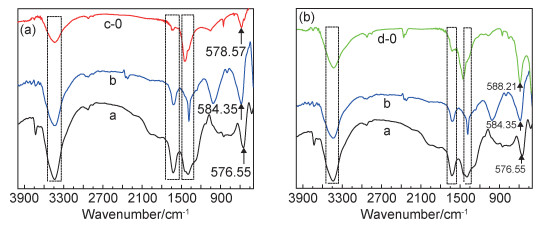
|
图 1 样品的FT-IR谱图 (a)样品a,b和c-0;(b)样品a,b和d-0 Fig. 1 FT-IR spectra of the samples (a)sample a, b and c-0;(b)sample a, b and d-0 |
样品a,b,c-0和d-0的XRD谱图如图 2所示。由图可见,高温固相反应法得到的YBCO样品a,其衍射峰均为YBCO超导相的特征衍射,对应晶面分别为(003), (013), (103), (005), (113), (006), (200), (116)和(213)[29]。样品b较样品a的XRD图衍射峰强度有所提高,可能是超声促进了样品a与空气中氧气的结合,提高了YBCO的结晶强度[15]。对比a, b, c-0和d-0的XRD衍射图,发现YBCO/有机物杂化材料无新的特征衍射峰,表明该掺入只是物理掺入,但衍射峰的强度显著提高,可见有机物有利于诱导其结晶。
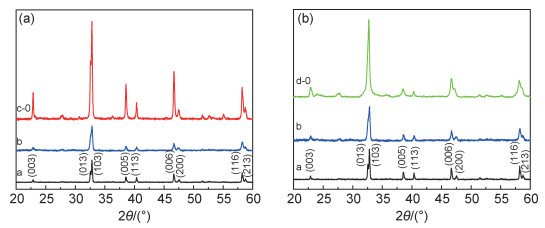
|
图 2 样品的XRD谱图 (a)样品a,b和c-0;(b)样品a,b和d-0 Fig. 2 XRD patterns of the samples (a)samples a, b and c-0;(b)samples a, b and d-0 |
对样品进行XPS测试,结果示于图 3。样品a, b, c-0, d-0中Y3d, Ba3d, Cu2p, O1s和N1s的精细谱分别对应图 3(a),(b),(c),(d)和(e)。谱图中样品b比a的XPS芯能级结合能更高,因为超声后得到的纳米YBCO平均颗粒尺寸较小,其表面原子所占比例大,因此表面能高且化学性质活泼[16]。也可归结为原子外弛豫效应的差异,在光电离时,与Koopman理论假设[30-31]不同,原子内外的电荷分布都会出现重排。纳米氧化物的粒径小,可贡献于极化作用的邻近原子很少,原子外的弛豫能更小。俄歇跃迁的终态有两个空穴,其引发的电子外弛豫比光电子发射引发的更强,所以动能位移更大。
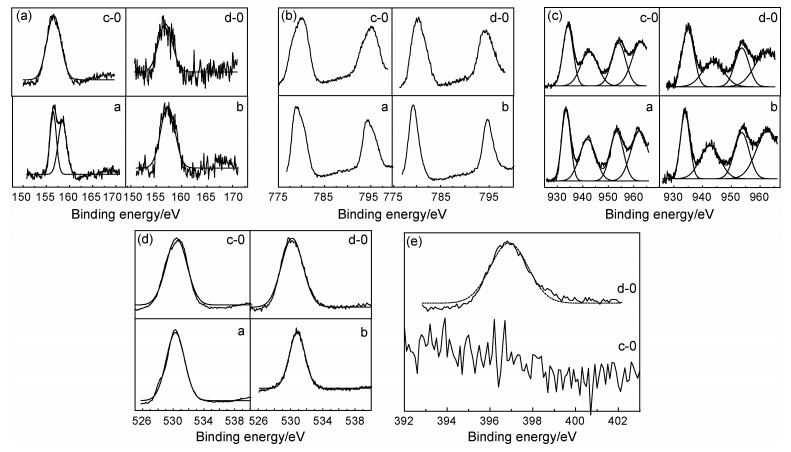
|
图 3 样品a,b,c-0和d-0的XPS谱图 (a)Y3d谱; (b)Ba3d谱; (c)Cu2p谱; (d)O1s谱; (e)c-0,d-0的N1s谱 Fig. 3 XPS spectra of samples a, b, c-0 and d-0 (a)Y3d spectrum; (b)Ba3d spectrum; (c)Cu2p spectrum; (d)O1s spectrum; (e)N1s spectra of c-0, d-0 |
对比b, c-0, d-0的Y3d, Ba3d, Cu2p, O1s和N1s的精细谱,可见Y3d, Ba3d, Cu2p, O1s的结合能均有改变。原子周围环境的改变影响电子云的屏蔽效应,从而改变结合能。由图 3中可见O1s向低结合能方向分别移动了0.85 eV和0.51 eV。与Y3d相比,Ba3d,Cu2p的谱峰变化不明显。Y3d的谱峰不规则且变宽减弱,同时向低结合能移动,表明Y-N间的相互作用强于Ba-N或Cu-N间的相互作用,N原子上的孤对电子更多地转移至Y3+的外层空轨道上,故其外层电荷密度增加,而内层电子结合能下降。可见c-0,d-0样品中Y,Ba,Cu和O原子的周围环境不同于纯YBCO,证实了Y-N间的相互作用。
2.4 磁性测试图 4是外加磁场为39.8×104 A/m下样品a,b,c-0~c-6的磁化强度随温度变化曲线图。由图中可见样品a在91.59 K处有一抗磁-顺磁转变,对应超导转变,与文献[32-34]结果一致。更低温度区间内磁化强度随温度的增加而降低,可能是磁性杂质或自旋-玻璃引起的[35-36]。经过超声后的YBCO样品b,超导转变温度Tc低于样品a。表 1列出了样品a,b,c-0~c-6的Tc(K)及最小磁化强度Mmin(A·m2·kg-1)数据。图 5是外加磁场为39.8×104A/m下样品a,b,d-0~d-6的磁化强度随温度变化曲线图。表 2是以上样品相应的Tc(K) 及Mmin(A·m2·kg-1)数据。结合图表可见,掺入不同量的苯胺并未显著影响YBCO的Tc和M。掺入邻苯二胺时,当掺入量低于3%时,对Tc和M的影响不明显,当掺入量达5%(样品d-0)时,Tc显著降低,降为60.33 K,对应Mmin为-0.0552(A·m2·kg-1)。结合XPS分析可知,苯胺、邻苯二胺N上的孤对电子转移到Y3+的外层空轨道上,增加了其外层电荷密度而影响YBCO的Tc和磁化强度M。虽然有机物的掺入量相同,但各有机物中N元素在样品中的含量仍较小,除样品d-0外,其他样品中N元素含量均不超过1%,故对YBCO的Tc和M的影响不明显。当N元素含量超过1%,样品的Tc明显降低,Mmin则相应提高,可见有机物掺入后样品中N元素含量对YBCO的Tc和M有显著影响。
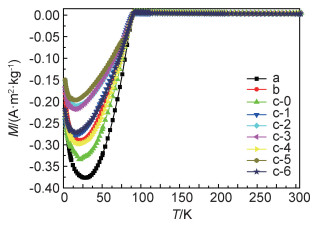
|
图 4 样品a, b, c-0, c-1, c-2, c-3, c-4, c-5和c-6的磁化强度随温度变化曲线 Fig. 4 Magnetization-temperature curves of samples a, b, c-0, c-1, c-2, c-3, c-4, c-5 and c-6 |
| Sample | Tc/K | Mmin/(A·m2·kg-1) |
| a | 91.59 | -0.3764 |
| b | 88.66 | -0.2897 |
| c-0 | 91.68 | -0.3343 |
| c-1 | 89.36 | -0.2766 |
| c-2 | 89.19 | -0.2105 |
| c-3 | 89.15 | -0.2177 |
| c-4 | 89.05 | -0.2976 |
| c-5 | 90.21 | -0.1940 |
| c-6 | 90.15 | -0.2721 |
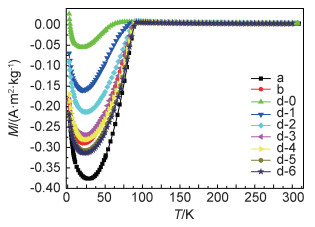
|
图 5 样品a, b, d-0, d-1, d-2, d-3, d-4, d-5和d-6的磁化强度随温度变化曲线 Fig. 5 Magnetization-temperature curves of samples a, b, d-0, d-1, d-2, d-3, d-4, d-5 and d-6 |
| Sample | Tc/K | Mmin/(A·m2·kg-1) |
| a | 91.59 | -0.3764 |
| b | 88.66 | -0.2897 |
| d-0 | 60.33 | -0.0552 |
| d-1 | 82.82 | -0.1597 |
| d-2 | 88.83 | -0.2132 |
| d-3 | 88.80 | -0.2700 |
| d-4 | 88.84 | -0.2810 |
| d-5 | 91.77 | -0.3075 |
| d-6 | 91.76 | -0.3138 |
(1) 掺入0.05%~5%的苯胺或邻苯二胺不影响YBCO的红外吸收,但有利于诱导其结晶,显著提高了XRD衍射峰的强度。
(2) 苯胺或邻苯二胺中N与YBCO中Y之间的相互作用比N-Ba或N-Cu强烈,N上的孤对电子更多地转移到Y3+的外层空轨道上。有机物掺入后样品中N元素含量对YBCO的超导转变温度Tc和磁化强度M有显著影响,N含量超过1%,Tc明显降低,Mmin则相应提高。
| [1] |
ZHANG H D, DING F Z, GU H W, et al. Fabrication of high-Jc BaTiO3-doped YBa2Cu3O7-d thin films by the low-fluorine TFA-MOD approach[J]. Journal of Alloys and Compounds, 2016, 664: 5-10. DOI:10.1016/j.jallcom.2015.12.220 |
| [2] |
OPHERDEN L, SIEGER M, PAHLKE P, et al. Large pinning forces and matching effects in YBa2Cu3O7-δ thin films with Ba2Y(Nb/Ta)O6 nano-precipitates[J]. Scientific Reports, 2016, 6: 1-10. DOI:10.1038/s41598-016-0001-8 |
| [3] |
LI G Z, DONG L, DENG X Y. Significant improvement of superconducting properties in nano-NiFe2O4-doped Y-Ba-Cu-O single-grain superconductor[J]. Journal of the American Ceramic Society, 2016, 99(2): 388-391. DOI:10.1111/jace.14035 |
| [4] |
BEN SALEM M K, ALMESSIERE M A, AL-OTAIBI A L, et al. Effect of SiO2 nano-particles and nano-wires on microstructure and pinning properties of YBa2Cu3O7-d[J]. Journal of Alloys and Compounds, 2016, 657: 286-295. DOI:10.1016/j.jallcom.2015.10.077 |
| [5] |
HWANG S M, SUNG K, CHOI J H, et al. O-free polyacrylonitrile doping to improve the Jc(B) and Hc2 of MgB2 wires[J]. Physica: C, 2010, 470(20): 1430-1434. DOI:10.1016/j.physc.2010.05.130 |
| [6] |
WANG C D, WANG D L, ZHANG X P, et al. Aniline doping and high energy milling to greatly enhance electromagnetic properties of magnesium diboride superconductors[J]. Physica: C, 2013, 489: 36-39. DOI:10.1016/j.physc.2013.04.010 |
| [7] |
NAKAGAWA K, HONMA T, TAKEDA K, et al. Intrinsic surface resistance of YBCO thin films under DC magnetic field[J]. IEEE Transactions on Applied Superconductivity, 2011, 21(3): 587-590. DOI:10.1109/TASC.2010.2086042 |
| [8] |
ARPAIA R, NAWAZ S, LOMBARDI F, et al. Improved nanopatterning for YBCO nanowires approaching the depairing current[J]. IEEE Transactions on Applied Superconductivity, 2013, 23(3): 1101505. DOI:10.1109/TASC.2013.2247454 |
| [9] |
CURTZ N, KOLLER E, ZBINDEN H, et al. Patterning of ultrathin YBCO nanowires using a new focused-ion-beam process[J]. Superconductor Science and Technology, 2010, 23(4): 24-37. |
| [10] |
NEMES N M, VISANI C, LEON C, et al. Magnetic memory based on La0.7Ca0.3MnO3/YBa2Cu3O7/La0.7Ca0.3MnO3 ferromagnet/superconductor hybrid structures[J]. Applied Physics Letters, 2010, 97(3): 032501. DOI:10.1063/1.3464960 |
| [11] |
UMEDA M, KATO M. Transition temperature enhancement of nano-structured superconductors: shape dependence and effects of Cooper pair distribution[J]. Physica: C, 2019, 560: 45-66. DOI:10.1016/j.physc.2019.02.012 |
| [12] |
LI G Z, WANG M, YANG W M. Enhanced superconducting properties in infiltration processed Y-Ba-Cu-O single-grain superconductor with nano-sized pinning centers[J]. Journal of Alloys and Compounds, 2015, 649: 559-563. DOI:10.1016/j.jallcom.2015.07.117 |
| [13] |
SHARMA S, AMALADASS E P, SHARMA N, et al. Enhanced superconductivity and superconductor to insulator transition in nano-crystalline molybdenum thin films[J]. Physica: B, 2017, 514: 89-95. DOI:10.1016/j.physb.2017.03.044 |
| [14] |
KASHIWAGI M, KATO M. Spatial dependence of odd-frequency spin-triplet superconducting order parameter in nano-sized s-wave superconductors under a magnetic field[J]. Physics Procedia, 2015, 65: 33-36. DOI:10.1016/j.phpro.2015.05.105 |
| [15] |
林珊, 陈淑卿, 章文贡, 等. 超声法制备金掺杂的纳米YBa2Cu3O7材料研究[J]. 华中师范大学学报, 2011, 45(1): 79-83. LIN S, CHEN S Q, ZHANG W G, et al. Preparation of YBCO with nano-Au-doping by ultrasonic process[J]. Journal of Huazhong Normal University, 2011, 45(1): 79-83. |
| [16] |
陈淑卿. 超声波法制备有机修饰纳米钇钡铜氧杂化材料研究[D]. 福州: 福建师范大学, 2009. CHEN S Q. Study on organic-modified nano Y-Ba-Cu-O hybrid materials obtained through ultrasonic process[D]. Fuzhou: Fujian Normal University, 2009. |
| [17] |
JASIM S E, JUSOH M A, HAFIZ M, et al. Fabrication of superconducting YBCO nanoparticles by electrospinning[J]. Procedia Engineering, 2016, 148: 243-248. DOI:10.1016/j.proeng.2016.06.595 |
| [18] |
DADRAS S, AAWANI E. Fabrication of YBCO nanowires with anodic aluminum oxide (AAO) template[J]. Physica: B, 2015, 475: 27-31. DOI:10.1016/j.physb.2015.06.016 |
| [19] |
YANG S L, ZHANG J. Deposition of YBCO nanoparticles on graphene nanosheets by using matrix-assisted pulsed laser evaporation[J]. Optics and Laser Technology, 2019, 109: 465-469. DOI:10.1016/j.optlastec.2018.08.039 |
| [20] |
COLIE M, MIHAIESCU D, SURDU A, et al. High temperature superconducting materials based on graphene/YBCO nanocomposite[J]. Materials Today: Proceedings, 2016, 3(8): 2628-2634. DOI:10.1016/j.matpr.2016.06.006 |
| [21] |
ALIKHANZADEH-ARANI S, SALAVATI-NIASARI M, ALMASI-KASHI M. Influence of the utilized precursors on the morphology and properties of YBa2Cu3O7-y superconducting nanostructures[J]. Physica: C, 2013, 488: 30-34. DOI:10.1016/j.physc.2013.02.007 |
| [22] |
SHEN Z, HU Y, FEI L, et al. Photocatalytically active YBa2Cu3O7-x nanoparticles synthesized via a soft chemical route[J]. Journal of Nanomaterials, 2015, 1: 1-5. |
| [23] |
GUO Y Q, YAHG X G, LI G, et al. Effect of ultrasonic intensification on synthesis of nano-sized particles with an impinging jet reactor[J]. Powder Technology, 2019, 354: 218-230. DOI:10.1016/j.powtec.2019.05.066 |
| [24] |
MODARRES-GHEISARI S M M, GAVAGSAZ-GHOACHANI R, MALAKI M, et al. Ultrasonic nano-emulsification-a review[J]. Ultrasonics Sonochemistry, 2019, 52: 88-105. DOI:10.1016/j.ultsonch.2018.11.005 |
| [25] |
SRIVASTAVA N, CHAUDHARI G P. Microstructural evolution and mechanical behavior of ultrasonically synthesized Al6061-nano alumina composites[J]. Materials Science and Engineering: A, 2018, 724: 199-207. DOI:10.1016/j.msea.2018.03.092 |
| [26] |
FETISOV A V, KOZHINA G A, ESTEMIROVAL S K, et al. XPS study of mechanically activated YBa2Cu3O6+δ and NdBa2Cu3O6+δ[J]. Journal of Spectroscopy, 2013, 1-13. |
| [27] |
李美超, 胡佳琦, 刘艳娜, 等. 红外光谱法研究苯胺和环氧丙烷的共聚机理及共聚物的表征[J]. 高等学校化学学报, 2008, 29(8): 1544-1548. LI M C, HU J Q, LIU Y N, et al. Studies on the mechanism of copolymerization of aniline and propylene oxide and characterization of copolymer via FTIR technique[J]. Chemical Journal of Chinese Universities, 2008, 29(8): 1544-1548. DOI:10.3321/j.issn:0251-0790.2008.08.010 |
| [28] |
包建军, 成煦, 何其佳, 等. 热处理过程中聚苯胺的结构变化[J]. 高分子材料科学与工程, 2004, 20(5): 121-124. BAO J J, CHENG X, HE Q J, et al. A study of polyaniline structure change undergoing heat treatment[J]. Polymeric Materials Science and Engineering, 2004, 20(5): 121-124. |
| [29] |
BRANESCU M, VAILIONIS A, GARTNER M, et al. Spectroscopic and X-ray diffraction study of high Tc epitaxial YBCO thin films obtained by pulsed laser deposition[J]. Applied Surface Science, 2006, 253(1): 400-404. DOI:10.1016/j.apsusc.2006.06.022 |
| [30] |
王雪, 江智渊, 蒋亚琪, 等. 高表面能晶面裸露的金属氧化物微纳米晶体的可控合成[J]. 中国科学: 化学, 2013, 12(43): 1630-1639. WANG X, JIANG Z Y, JIANG Y Q, et al. Shape-controlled synthesis of metal oxides micro/nanocrystals enclosed by crystal facets of high surface energy[J]. Scientia Sinica: Chimica, 2013, 12(43): 1630-1639. |
| [31] |
赵志娟, 刘芬, 邱丽美, 等. 纳米粒子尺寸效应引起的内层电子结合能位移[J]. 物理化学学报, 2008, 9(24): 1685-1688. ZHAO Z J, LIU F, QIU L M, et al. Core level binding energy shifts caused by size effect of nanoparticles[J]. Acta Physico-chimica Sinica, 2008, 9(24): 1685-1688. |
| [32] |
赵忠贤, 陈立泉, 杨乾声, 等. Ba-Y-Cu氧化物液氮温区的超导电性[J]. 科学通报, 1987, 6: 412-414. ZHAO Z X, CHEN L Q, YANG Q S, et al. The superconductivity of Ba-Y-Cu oxide in the liquid nitrogen temperature zone[J]. Chinese Science Bulletin, 1987, 6: 412-414. |
| [33] |
VOLOCHOVÁ D, PIOVAR I S, RADUŠOVSKÁ M, et al. YBCO bulk superconductors doped with gadolinium and samarium[J]. Physica: C, 2013, 494: 36-40. DOI:10.1016/j.physc.2013.04.009 |
| [34] |
STEIGER B, MARKOVISCH W, LANG W, et al. Systematic modification of electrical and superconducting properties of YBCO and nano-patterning of high-Tc superconducting thin films by light-ion irradiation[J]. Physics Procedia, 2012, 36: 508-513. DOI:10.1016/j.phpro.2012.06.075 |
| [35] |
储海峰, 李洁, 李绍, 等. Sr2CoO4-δ薄膜中的自旋玻璃态的磁性质研究[J]. 物理学报, 2010, 59(9): 6585-6592. CHU H F, LI J, LI S, et al. Glassy magnetic behaviors in oxygen-deficient Sr2CoO4-δ films[J]. Acta Physica Sinica, 2010, 59(9): 6585-6592. |
| [36] |
朱中华. YBCO及其复合体系的超导和磁性研究[D]. 兰州: 兰州大学, 2013. ZHU Z H. The investigation of superconducting and magnetic properties for YBCO and its composites[D]. Lanzhou: Lanzhou University, 2013. |
 2021, Vol. 49
2021, Vol. 49


